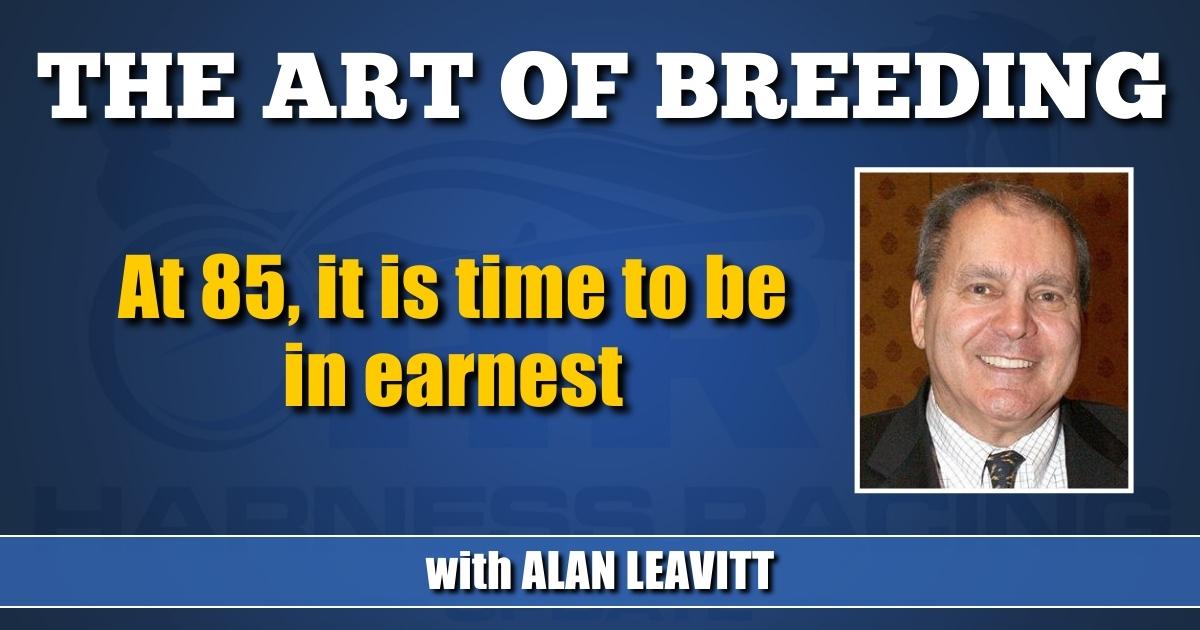At 85, it is time to be in earnest
by Alan Leavitt
After running literally hundreds and hundreds of five-generation pedigrees, I know with certainty that there is virtually no inbreeding within the American standardbred at this point in time.
That means we will see no fertility loss as the current racing stars leave the track and enter the stud. That has not always been the case. While the American pacer has never in the past 50 years paid any price for close breeding, the American trotter did.
The technical term that describes that problem is a loss of heterozygosity, the variability factor. The most notable stallion who suffered under the burden of limited fertility was Valley Victory. Despite small foal crops, VV sired three Hambletonian winners and numerous other tip stakes winners.
Yet, when one looks at V²’s five generation pedigree, there is no answer to be seen there, because there is no close breeding. The closest thing to an answer I can supply is through his second dam, Victorious Lou.
She’s a daughter of Noble Victory, the first million-dollar standardbred when I syndicated him in 1966. Vic was a great racehorse. Trained by Stanley Dancer, his only failure came in the Hambletonian, which he came to as the overwhelming favorite. However, it had rained buckets the day before, and the clay track at DuQuoin was like glue. Noble couldn’t handle the heavy going, although he did make his best showing when he finished third in the third heat as the track was staring to dry.
The ultimate winner that day was Noble’s stablemate, Egyptian Candor. Del Cameron drove him wearing a pair of blue pants Dancer had given him that day. After Cameron won the Hambletonian in his new blue pants, Dancer swore Cameron didn’t take them off for the next three weeks.
I know this is a reach, but as great a racehorse as Noble was, he was inbred 2 by 4 to Volomite, and he had less-than-perfect fertility. I think that with his potency, Noble Victory passed on to Valley Victory’s dam his limited fertility gene, and she passed it on to her son Valley Victory.
When one is dealing with questions involving standardbreds, there is always an answer to be found, if one only looks hard enough. Which is why a racehorse will invariably improve after being checked and worked on by a top vet, i.e. a Dr. Melissa McKee, and a Dr. Jennifer Stowe.
Having said all this, there is always an exception that proves the rule. In this case I found it when I printed out the five generation pedigree of Instagram Model.
She’s a 2-year-old filly who sold for $350,000 last fall as a yearling. She caught my eye because she just won her first baby race in 2, 2:03.1. Which leaves a lot of open water between that race and $350,000 plus, but every journey starts with the first step.
Instagram Model is inbred, 3 by 3, because on her Tail-Male side Conway Hall is her great grandsire, and on the bottom, on the Tail-Mare, we have Conway Hall’s full sister, Emilie Cas El, in the third generation.
Both of these names resonate with me, since Meg and I bred Conway Hall and Emilie Cas El, who was only the second 2-year-old to be voted Horse of the Year in Canada and was a major reason I bought her sire, Garland Lobell.
Here, a note regarding how stallions are properly handled. When I went up to Quebec to take an up-close and personal look at Garland, he was in the middle of a barn full of mares.
Being a know-it-all in the horse business, when I syndicated Garland, I just put him into the famous Walnut Hall stud barn. If it was good enough for Scotland and Volomite, of course it was good enough for Garland.
Except that it wasn’t. As long as he was stabled within sight and sound of other studs, he didn’t breed as well as he had in Quebec, surrounded only by his harem.
Now I think it’s common knowledge that every stallion will breed better if he’s only exposed to mares, both in his stabling and when turned out. Well, maybe I shouldn’t put it that way, because I know there are some big operators in our biz who keep all their studs in the same barn, and turn them out in the adjacent paddocks.
MEA Culpa
Finally, a huge Mea Culpa for what I wrote two weeks ago about the great thoroughbred stallion Mr. Prospector. Obviously I had the wrong horse, for which I am profoundly sorry.
The man who put me in my place was Dr. Douglas Koch, of Berkshire Stud, in Pine Plains, NY. I have been going bonkers trying to reach Dr. Koch, whose listed number no longer rings through.
He’s totally right that I was totally wrong attributing that hard luck story to Mr. Prospector. But I know what I wrote does correctly apply to another thoroughbred stallion, and I thought Dr. Koch could supply me with the correct name.
Again, here, I’m guided by Dr. Samuel Johnson, viz;
“At eight-five, it is time to be in earnest.”
















